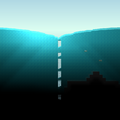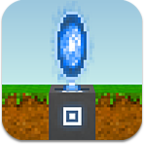Water

Water is a fluid block that can be a barrier to travel or a useful resource.
Appearance
The pattern for water is animated to suggest fluid motion. Its color varies with available light, but is typically some shade of cyan or blue-green.
Where Found
Water occurs naturally on the surface of a generated world in the form of bodies of water such as ponds, lakes, and oceans. It can also spawn underground, partially or completely filling caverns.
Characteristics
Flowing
Water will flow from one block to another, if an adjacent block is removed, a block is added in space occupied by water, or when a bucket of water is emptied. Water will seek to fill the lowest available space but will not decrease in volume doing so, which can result in spaces being partially filled with water.
Water will flow over drop-offs and "splash" across the top of blocks. This can cause unexpected problems as water will dislodge placed items such as ladders or oil lanterns, dropping them for pick-up by the next blockhead that passes them. Other placed items such as steel lanterns are unaffected.
Whether water will flow between two adjacent partially filled blocks appears to be determined by comparing their relative levels. If there is insufficient difference, there will be no flow. This can result in a very gentle, descending gradient across long expanses. (In one test, there was a drop of 28 pixels over a span of some 93 blocks with 80-pixel blocks after the water settled.) A significant difference in water height will cause "splash" particles to be produced as the water flows.
Flowing water will "push" items floating on top of it in the direction of the flow.
When multiple water blocks are directly over air blocks, there may be a flickering pattern of air and water as the two trade places.
Freezing
Free-standing water (or poured from a bucket) in an area experiencing sufficient cold (such as falling snow) or space may freeze into ice if it sufficiently fills a block. Trace water may disappear. Under warmer conditions, ice may melt into water. Melted ice is typically replaced by the same volume of water that froze.
Water close enough to cold air will freeze into ice, the distance dependent on the degree of cold. Conversely, ice close enough to warm air will melt.
Boiling

Free-standing water that's close enough to a heat source (such as magma, a campfire, a furnace, or burning blocks) will begin boiling, giving off "puffs of steam" in the form of white dots that quickly shrink and disappear. No water is lost, however.
Water at the correct temperature will, as of version 1.3, heal a blockhead immersed in it. This does not prevent a blockhead from being hurt when swimming too close to magma.
Evaporation
If water fills less than one whole block on top of magma, it does not turn into basalt and instead evaporates into steam and disappears.
Dissipation
If standing water is low enough in a block space, it may "evaporate" and despawn. When water is less than 1/28 the height of a block, it disappears from that block. This may allow water from an adjacent block to flow in and repeat the process, eventually lowering the water level in the other block to less than 1/28 of a block deep as well. This effect can slowly clear large areas of shallow water.
Harvesting
It's not possible to pick up water directly, but may be picked up and carried when frozen into ice and allowed to melt when placed later.
Using a bucket on water will change the bucket into a bucket of water and removes the water from the affected space. This can be done on even partially filled spaces containing more than one-eighth of a block of water.
Drowning
A blockhead who has its head fully immersed in water will suffer from a lack of air and begin reducing their air bar unless the blockhead continues to eat kelp. Once the air bar is empty, the blockhead's health will start to decrease.
If a blockhead drowns in warm water, the healing effect of the water will counteract the loss of health.
Uses
Water cannot be used directly for crafting, but is needed for some crafting recipes in the form of a bucket of water.
Kelp cannot be planted in a block that isn't under sufficient water. It will then grow upward until it reaches a solid block or the block of water immediately below air.
Placing water directly atop magma will create a block of unharvested basalt. This must be done from a bucket; water that is naturally spawned or flows down to magma will not become basalt.
Notes
Due to some quirks of how it is implemented, water may be generated in two ways:
- Water that partially fills a space will freeze into a full block of ice, which may then melt into a full block of water. However, as of 1.4, ice melts back into the same one-block water level that froze unless mined and replaced.
- Water spilling into two or more open blocks may allow each partially filled space to be picked up by a bucket, which when emptied will produce a full block of water. (This effect is diminished in Expert Mode.)
If a solid block is placed in a well-submerged location, there is little noticeable change in water level. This suggests that the water is replaced rather than displaced. This does not happen near or at the surface of the water unless there is a solid block immediately above where the new one is being placed.
Gallery
-
Water draining down an irregular vertical shaft, note the flowing accumulation at the bottom
-
Over 100 blocks of water draining from an ocean into an unseen submarine cave; it started when the player's blockhead approached in a boat
-
Snow hanging in the air, the ice it had been on melted into partial water
-
HD water (in stone)




